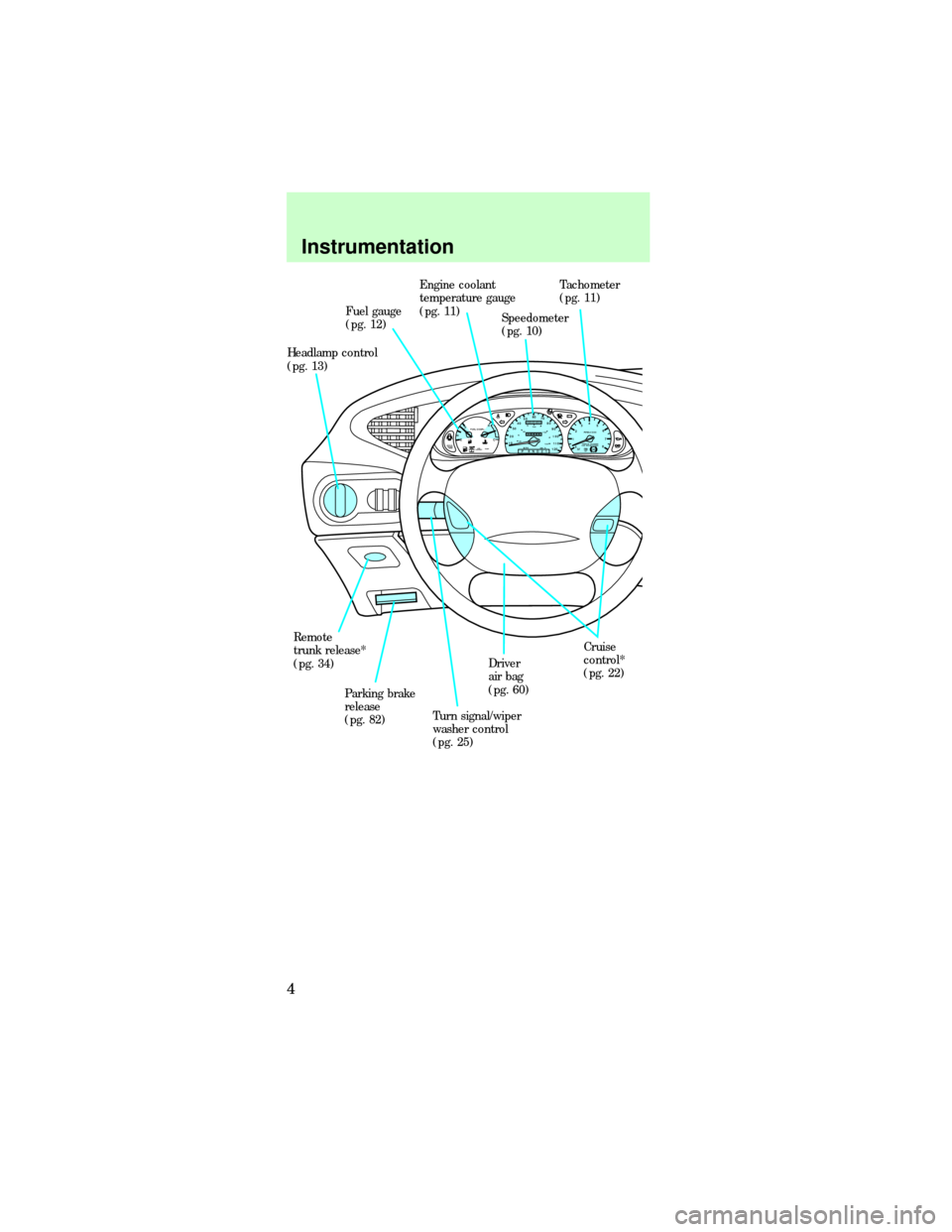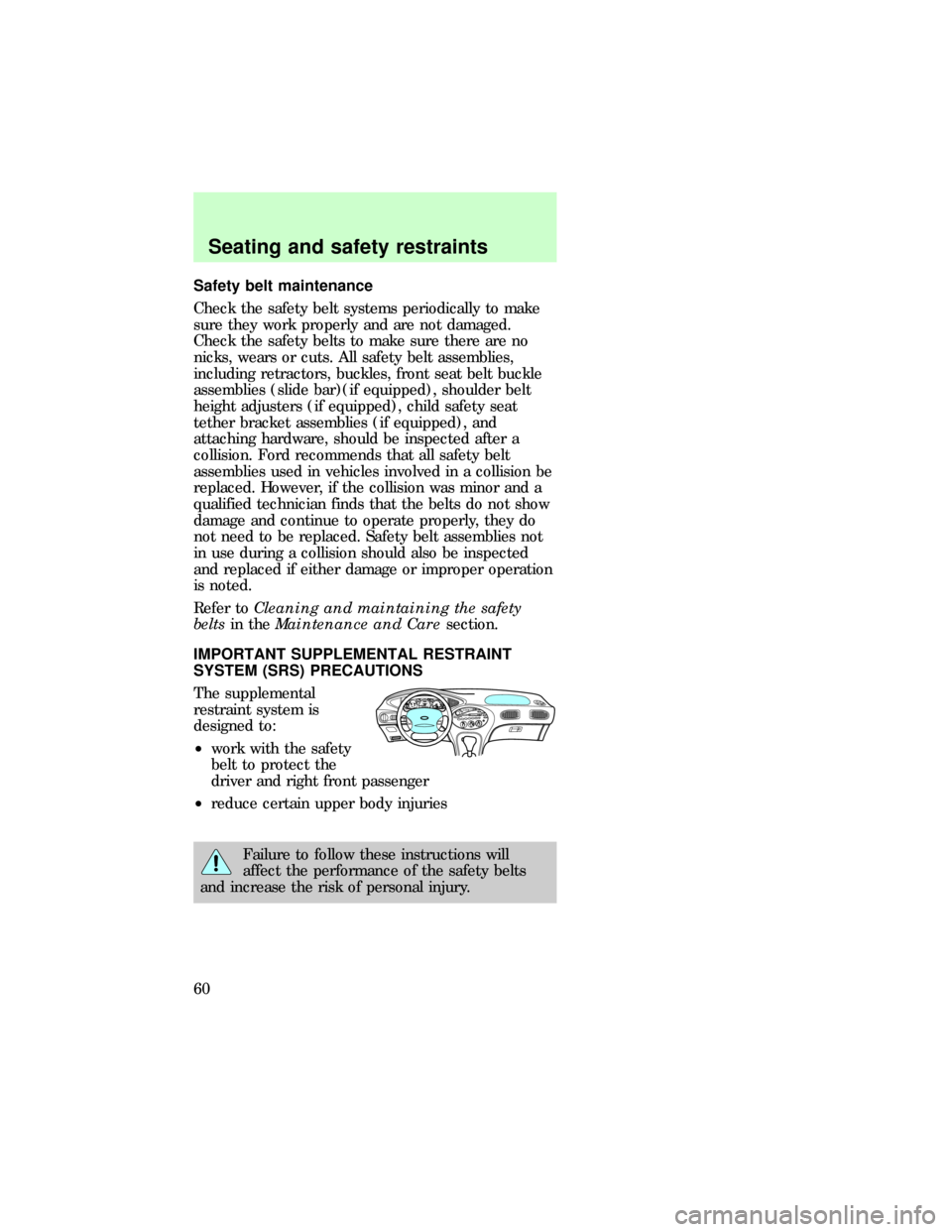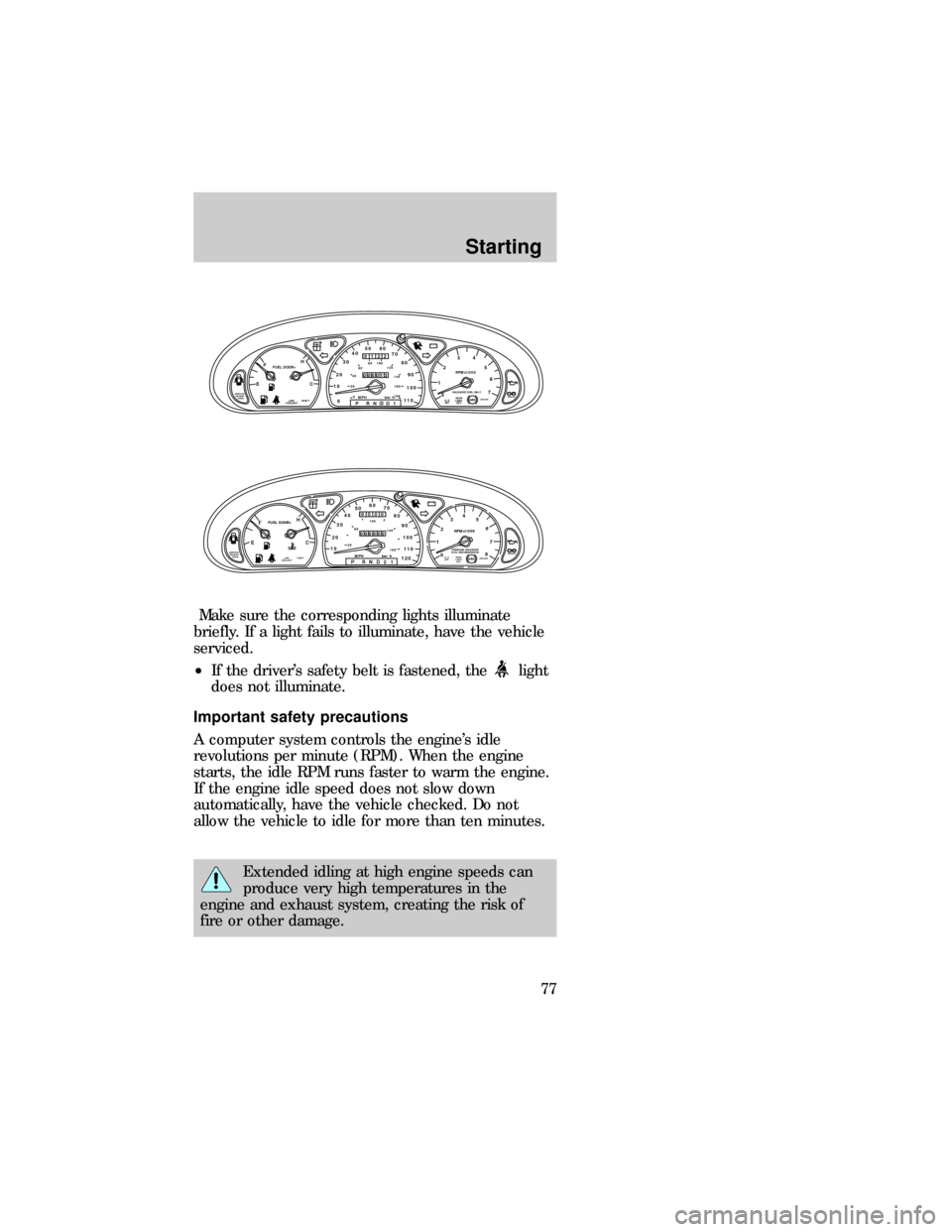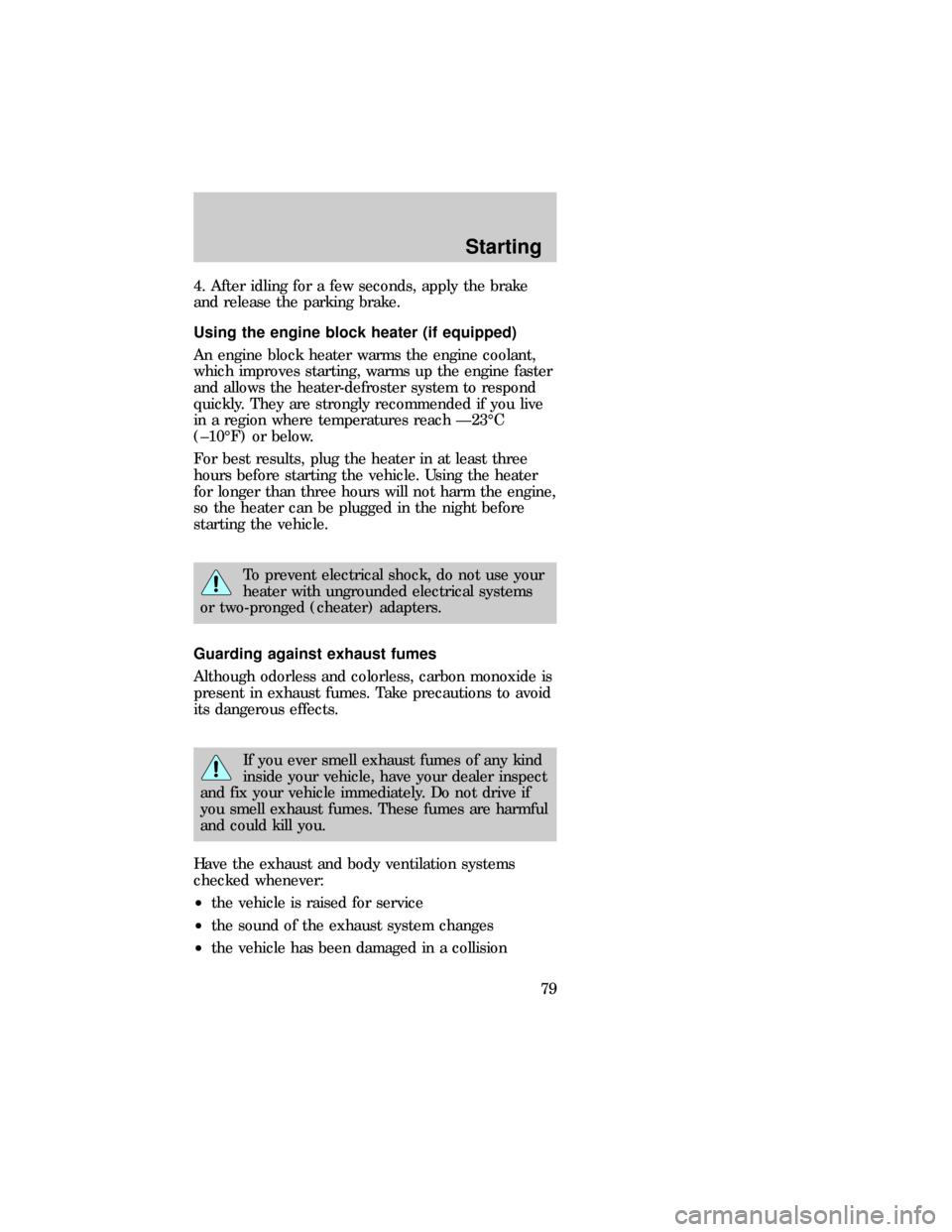service Mercury Sable 1997 Owner's Manuals
[x] Cancel search | Manufacturer: MERCURY, Model Year: 1997, Model line: Sable, Model: Mercury Sable 1997Pages: 167, PDF Size: 1.59 MB
Page 4 of 167

BASSTREBBALFADEREWFFEJECT
1234
56wTAPE SIDETAPE
R-DEFTUNESEEKSCAN AM
FM
MH
LO
HIOFF
A/C
MAX
A/CVENT
VOL
PUSH-ON
wSTFM 12
AMCBLRF
EFC HFUEL DOOR>
SERVICE
ENGINE
SOONLOW
COOLANTTHEFT102030405060
70
80
90
100
1202060100
140
180P R N D 2 1MPH km/h0000000000P!
BRAKE
+ Ð
110CRUISE
RPMx1000
ABSO/D
OFFREAR
LAMP
OUTPREMIUM UNLEADED
FUEL RECOMMENDED0 1234
5
6
78
Fuel gauge
(pg. 12)
Headlamp control
(pg. 13)Engine coolant
temperature gauge
(pg. 11)
Speedometer
(pg. 10)Tachometer
(pg. 11)
Driver
air bag
(pg. 60)Cruise
control*
(pg. 22)
Turn signal/wiper
washer control
(pg. 25) Parking brake
release
(pg. 82) Remote
trunk release*
(pg. 34)
Instrumentation
4
Page 6 of 167

WARNING LIGHTS AND GAUGES
Standard instrument cluster
Optional instrument cluster
Turn signal
Illuminates when the
left or right turn signal
or the hazard lights are
turned on.
High beams
Illuminates when the
headlamp high beams
are on.
CRUISE
RPMx1000
0 1234
5
6
7EFC H
FUEL DOOR>
SERVICE
ENGINE
SOON1020304050 60
70
80
90
100
110
00 20406080100
120
140
160
180P R N D D 1MPH km/h
00
122
00013
P!
BRAKEABS
+ –
UNLEADED FUEL ONLY
THEFT LOW
COOLANTO/D
OFF
EFC H
FUEL DOOR>
SERVICE
ENGINE
SOON
THEFT102030405060
70
80
90
100
1202060100
140
180
P R N D 2 1MPH km/h
00
000
00000
P!
BRAKELOW
COOLANT
+ –
110CRUISE
RPMx1000
ABSO/D
OFFPREMIUM UNLEADED
FUEL RECOMMENDED0 1234
5
6
78
dno_optional
com_turn_signal.01
com_high_beams.01
com_safety_belt.01
Instrumentation
6
Page 7 of 167

Safety belt
Illuminates when the
ignition is switched on
to remind you to fasten
your safety belts. For
more information, refer toUsing the safety
restraints properlyin theSeating and safety
restraintschapter.
Door ajar
Illuminates when the
ignition switch is in the
ON or START position
and any door is open.
Service engine soon
This light illuminates
when the engine's
Emission Control
System requires
service. It will also
illuminate when the ignition key is in the ON
position and the engine is off.
Low fuel
If the fuel gauge
reaches approximately
1/16th of a tank, this
lamp will illuminate.
The ignition must be turned on for this lamp to
illuminate.
Low coolant (if equipped)
This lamp will
illuminate when the
engine coolant inside
the reservoir is low.
This lamp will come on
when the ignition is first turned on, but then should
turn off. If the lamp stays on and a chime sounds,
SERVICE
ENGINE
SOON
LOW
COOLANT
com_door-ajar.02
dno_service-engine
dno_low-fuel
dno_low-coolant
Instrumentation
7
Page 8 of 167

you should check the coolant level inside the
reservoir. For instructions on adding coolant, see
Engine coolantin the index.
Anti-theft alarm light (if equipped)
This light is used when
you set the anti-theft
alarm system. See
Anti-theft systemin
the index.
O/D off (if equipped)
Illuminates when the
transaxle control
switch (TCS) has been
pushed. When the light
is on, the transaxle does not shift into overdrive. If
the light does not come on when the TCS is
depressed or if the light flashes when you are
driving, have your vehicle serviced.
Anti-lock brake system (ABS) (if equipped)
Momentarily illuminates
when the ignition is
turned on and the
engine is off. If the
light stays on or continues to flash, the ABS needs
to be serviced.
Cruise control (if equipped)
This light comes on
when the cruise control
ON button is pressed.
It turns off when the
cruise control OFF
button is pressed or when the ignition is turned to
the OFF position.
THEFT
O/D
OFF
ABS
CRUISE
dno_theft
dno_overdrive-off
dno_abs
dno_cruise-light
com_brake_system.01
Instrumentation
8
Page 9 of 167

Brake system warning
Extinguishes when the
parking brake is
released. Illumination
after releasing the
parking brake indicates low brake fluid level.
Engine oil pressure
When the oil pressure
is below the normal
operating range, this
lamp will illuminate.
The engine oil level being too high or too low could
cause this lamp to illuminate. This lamp will come
on when the ignition is first turned on but then
should turn off. If the lamp stays on, continued
operation will cause severe engine damage.
Charging system
Briefly illuminates
when the ignition is
turned on and the
engine is off. The light
also illuminates when the battery is not charging
properly, requiring electrical system service.
Air bag readiness
Briefly illuminates
when the ignition is
turned on and the
engine is off. If the
light fails to illuminate, continue to flash or remains
on, have the system serviced immediately.
Headlamps on warning chime
Sounds when the headlamps are on, the ignition is
off (and the key is not in the ignition) and the
driver's door is opened.
P!
BRAKE
dno_engine-oil-pressure
com_charging_system.01
dno_srs-light
dno_warning-lights
com_headlamps_chime.01
com_key_chime.01
Instrumentation
9
Page 60 of 167

Safety belt maintenance
Check the safety belt systems periodically to make
sure they work properly and are not damaged.
Check the safety belts to make sure there are no
nicks, wears or cuts. All safety belt assemblies,
including retractors, buckles, front seat belt buckle
assemblies (slide bar)(if equipped), shoulder belt
height adjusters (if equipped), child safety seat
tether bracket assemblies (if equipped), and
attaching hardware, should be inspected after a
collision. Ford recommends that all safety belt
assemblies used in vehicles involved in a collision be
replaced. However, if the collision was minor and a
qualified technician finds that the belts do not show
damage and continue to operate properly, they do
not need to be replaced. Safety belt assemblies not
in use during a collision should also be inspected
and replaced if either damage or improper operation
is noted.
Refer toCleaning and maintaining the safety
beltsin theMaintenance and Caresection.
IMPORTANT SUPPLEMENTAL RESTRAINT
SYSTEM (SRS) PRECAUTIONS
The supplemental
restraint system is
designed to:
²work with the safety
belt to protect the
driver and right front passenger
²reduce certain upper body injuries
Failure to follow these instructions will
affect the performance of the safety belts
and increase the risk of personal injury.
BASSTREBBALFADEREWFFEJECT1234
56wTAPE SIDETAPE
R-DEFTUNESEEKSCAN AM
FMMHLO
HIOFF
A/C
MAX
A/CVENTVOL
PUSH-ONwSTFM 12
AMCBLRFEFC HFUEL DOOR>SERVICE
ENGINE
SOONLOW
COOLANTTHEFT102030405060
70
80
90
100
1202060100
140
180P R N D 2 1MPH km/h0000000000P!
BRAKE+ –110CRUISERPMx1000ABSO/D
OFFREAR
LAMP
OUTPREMIUM UNLEADED
FUEL RECOMMENDED0 1234
5
6
78
dno_belt-maintenance
com_important_precautions.01
Seating and safety restraints
60
Page 61 of 167

The right front passenger air bag is not
designed to restrain occupants in the front
seating position.
Do not place objects or mount equipment on
or near the air bag covers that may come
into contact with an inflating air bag.
Do not attempt to service, repair, or modify
the Air Bag Supplemental Restraint System
or its fuses. See your Ford or Lincoln-Mercury
dealer.
CHILDREN AND AIR BAGS
For additional important safety information, read all
information on safety restraints in this guide.
Children should always wear their safety belts.
Failure to follow these instructions may increase the
risk of injury in a collision.
Rear-facing
child seats or
infant carriers should
never be placed in
the front seats.
com_children.01
Seating and safety restraints
61
Page 64 of 167

If any of these things happen, even intermittently,
have the SRS serviced at your dealership or by a
qualified technician immediately. Unless serviced,
the system may not function properly in the event of
a collision.
DISPOSAL OF AIR BAGS AND AIR BAG
EQUIPPED VEHICLES
For disposal of air bags or air bag equipped vehicles,
see your local dealership or qualified technician. Air
bags MUST BE disposed of by qualified personnel.
IMPORTANT CHILD RESTRAINT PRECAUTIONS
You are required by law to use safety restraints for
children in the U.S. and Canada. If small children
ride in your vehicle (generally children who are four
years old or younger and who weigh 18 kg [40 lbs]
or less), you must put them in safety seats made
especially for children. Check your local and state or
provincial laws for specific requirements regarding
the safety of children in your vehicle.
Never let a passenger hold a child on his or
her lap while the vehicle is moving. The
passenger cannot protect the child from injury in a
collision.
Always follow the instructions and warnings that
come with any infant or child restraint you might
use.
When possible, place children in the rear seat of
your vehicle. Accident statistics suggest that
children are safer when properly restrained in the
rear seating positions than in the front seating
position.
dno_pass-srs
com_disposal.01
com_important_precautions.04
com_safety_belts.01
Seating and safety restraints
64
Page 77 of 167

Make sure the corresponding lights illuminate
briefly. If a light fails to illuminate, have the vehicle
serviced.
²If the driver's safety belt is fastened, the
light
does not illuminate.
Important safety precautions
A computer system controls the engine's idle
revolutions per minute (RPM). When the engine
starts, the idle RPM runs faster to warm the engine.
If the engine idle speed does not slow down
automatically, have the vehicle checked. Do not
allow the vehicle to idle for more than ten minutes.
Extended idling at high engine speeds can
produce very high temperatures in the
engine and exhaust system, creating the risk of
fire or other damage.
CRUISE
RPMx1000
0 1234
5
6
7EFC H
FUEL DOOR>
SERVICE
ENGINE
SOON1020304050 60
70
80
90
100
110
00 20406080100
120
140
160
180P R N D D 1MPH km/h
00
122
00013
P!
BRAKEABS
+ –
UNLEADED FUEL ONLY
THEFT LOW
COOLANTO/D
OFFREAR
LAMP
OUT
EFC H
FUEL DOOR>
SERVICE
ENGINE
SOONTHEFT102030405060
70
80
90
100
1202060100
140
180
P R N D 2 1MPH km/h
00
000
00000
P!
BRAKELOW
COOLANT
+ –
110CRUISE
RPMx1000
ABSO/D
OFFREAR
LAMP
OUTPREMIUM UNLEADED
FUEL RECOMMENDED0 1234
5
6
78
com_important_precautions.05
Starting
77
Page 79 of 167

4. After idling for a few seconds, apply the brake
and release the parking brake.
Using the engine block heater (if equipped)
An engine block heater warms the engine coolant,
which improves starting, warms up the engine faster
and allows the heater-defroster system to respond
quickly. They are strongly recommended if you live
in a region where temperatures reach Ð23ÉC
(±10ÉF) or below.
For best results, plug the heater in at least three
hours before starting the vehicle. Using the heater
for longer than three hours will not harm the engine,
so the heater can be plugged in the night before
starting the vehicle.
To prevent electrical shock, do not use your
heater with ungrounded electrical systems
or two-pronged (cheater) adapters.
Guarding against exhaust fumes
Although odorless and colorless, carbon monoxide is
present in exhaust fumes. Take precautions to avoid
its dangerous effects.
If you ever smell exhaust fumes of any kind
inside your vehicle, have your dealer inspect
and fix your vehicle immediately. Do not drive if
you smell exhaust fumes. These fumes are harmful
and could kill you.
Have the exhaust and body ventilation systems
checked whenever:
²the vehicle is raised for service
²the sound of the exhaust system changes
²the vehicle has been damaged in a collision
com_engine_heater.01
com_guarding_exhaust.01
com_ventilation_info.01
Starting
79